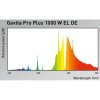Lumens doesn't tell the entire story. In general, a light that produces more lumens is usually better, but not all lumens are the same power, so it's not always true. 10,000 lumen of 660nm light is ~240W of radiometric power while 10,000 lumens of 555nm is only ~15W. It can be somewhat deceptive when comparing lights with very different spectral distributions.
What we really want is radiometric power, which is measured in watts, or photon flux, which is measured in umol/s.
Determining which wavelengths are more efficient for the plant is a lot more complicated than originally expected when led pioneers started out making R+B arrays. From all the results, it seems like R+B is good under low intensity, but at high intensities, "lower quality" wavelengths start to become essential for high yields and good health.
The main difference between the 2700k and 3500k, given the same CRI, is the amount of phosphor coating used, but the spectral peak of the wide band produced is not shifted to a higher wavelength. (at least not significantly)
All of the higher CRI phosphor blends have a wide band peak more toward the red than the 80cri versions. Adding more phosphor will not cause the band to move, and have minor affect on the bandwidth. The band only gets larger in both peak and the area under the curve (total power).
If you really want more red, you should get 660nm leds and produce that narrow band directly. The 2700k at 80cri gives you more "yellow" more than it gives you more red.
Anyone can look at the spec sheets and see the high CRI takes a big hit on the lumens. The gist of the thread makes sense. It's complicated but the question comes down to whether avoiding heavy green is more efficient for the plant. If there's an overall lumen loss, but the total lumens in red/blue increases it might be worth using two color spectrums. There might be a way to deduce that from the charts but I'm not sure how it would be done.
So, do the 2700s contain more red than the 3500s, or just less green/blue?
My current spectrum 3000/4000 at about a 2:1 ratio really puts a damper on the stretch. I've gotten maybe 8" in the first 4 weeks, and with scrog that's not much. Kinda makes me wish I had went with the 2700s, but if it were sacrificing lumens without increasing the total amount of red I might change my position.





